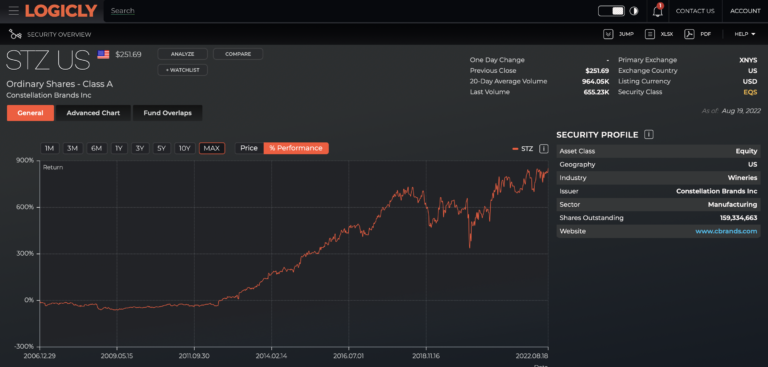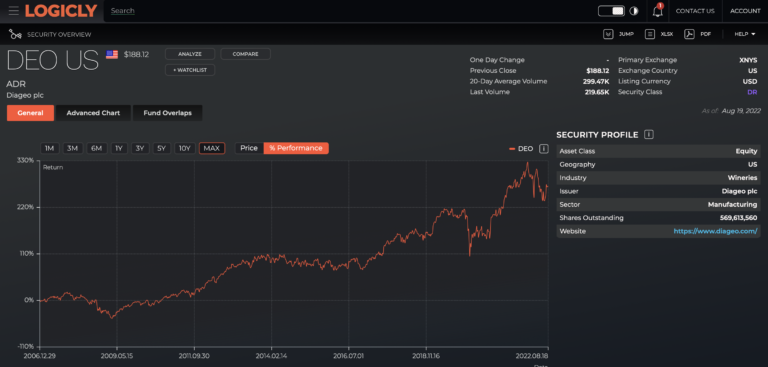
By: Brian Fechter
brian.fechter@thinklogicly.com

The markets need a drink
In the six months between January and July of 2022, US markets experienced some of the largest losses in recent memory. In that timeframe, the S&P returned an astonishing -20%. Coinciding with this monumental downturn, the US is currently living through record levels of inflation that have even the savviest of investors a bit unnerved.
During this time, market participants and asset managers alike are scrambling to sit on the sidelines accumulating greater cash positions, or moving into alternative assets that will act as the prophetic “inflation hedge” to get them through these turbulent conditions.
Assets seen as stores of value include Bonds, Gold, Real Estate, and (more recently) Bitcoin, are being considered and added to portfolios at rapid rates to combat fiscal and overall economic uncertainty.
Among all fan favorite alternative assets mentioned during market downturns, the one asset that has stealthily performed well (and in some cases, the best) may come to you as a shock: fine wine!
Decanting wine as an asset
A good vino may not be the first thing that comes to mind when thinking of alternative assets. But one can’t help to think “wine” not, since the investment characteristics of wine align with the same principles that have driven people and the markets to invest in gold since the 1800s.
Both are historically stable assets during market volatility and both have scarcity factors that attribute to their stability. Gold is scarce due to it being found in low natural concentrations and the difficulty of its extraction process. Fine wine’s scarcity is attributed to supply levels that are dictated by specific geographic qualities in a region needed for the grapes and soil to meet the standard of being deemed a “fine wine”.
Wine is not identical to other popular alternative assets by any means.
The differences between assets like gold and bonds compared to wine are what may make it an attractive investment. The performance of gold and bonds is heavily influenced by the direction of mainstream financial markets at large, whereas wine’s performance is driven by intra-market supply and demand coupled with the notoriety and prestige of the vineyards producing them.
For investors seeking protection from the erosion power of inflation, the idea of a historically stable asset that isn’t correlated to other markets sounds like a dream come true. It’s also an added bonus that fine wine is one of the few assets (sans commodities) that you can both consume and sell on the markets for a profit!
How are the “legs”?
So, how is the performance of fine wine monitored?
The Liv-ex 1000 index is known to be the broadest way to measure and gauge the performance of the fine wine market. Liv-ex tracks 1,000 wines from across the world through seven different sub-indices representing various regions around the globe.
An interesting observation: the performance of the “legs” of wine as an asset during a market downturn. Recall the above-referenced abysmal first half of the year where the S&P 500 was down 20%.
During the same period, wine recorded a return of 11%. This, while gold prices were stagnant, bonds fell by almost 10%, and Bitcoin tanked a whopping 59%.
Over one year, from July 2021 to July 2022, wine outperformed the other assets mentioned by a country mile. Wine returned just over 30%, while Bitcoin cratered 28%, bonds dropped 11%, S&P 500 fell nearly 10%, and gold dipped about 6%.
For those who might argue that it’s only one year of performance, let’s take a look at returns from the beginning of COVID-19 in February 2020 through the start of July 2022. In this period, wine returns jumped 41%, as bonds slid 8%, and both gold and the S&P 500 were up 10% and 17%, respectively.
It is worth noting, that while Bitcoin was the top performer by a long shot in this timeframe at 133%, those returns came with greater volatility than any of the other assets, as you can see in the other timeframes mentioned above.
More than a Beverage
Fine wine has been enjoyed and even collected for generations. With the creation of the Liv-ex 1000 in 2004, investors were finally able to analyze and track the wine markets in the same way we do financial markets around the globe.
Historically, fine wine has been inaccessible to those outside the regions they are produced. And even in more modern times, the logistics and costs associated with sourcing fine wine make it difficult for the everyday investor to purchase.
Nowadays, there are infinite resources and channels to purchase fine wine in person, online, and in some instances directly from the vineyards. There have also been investing platforms created to allow retail investors to partake in fractional ownership (buying shares of an asset vs purchasing the asset in its entirety), with some even handling the shipping and storage logistics of your purchases for you.
The realized investment potential and widespread affinity for wine around the world have allowed for it to become far more than a beverage of enjoyment. Wine has transcended into a full-blown fiscal market that is drawing the attention of retail investors, HNW individuals, and even Web3 investors.
Evinco Winery DAO is the first Web3 winery where ownership of the NFT acts as membership to an organization of wine connoisseurs who invest in their wine both digitally and physically. This membership gives owners access to Napa Valley tasting rooms, fine wine libraries, and free bottles of vintage wine developed specifically for Evinco.
For beginners who are interested in taking a sip, there are low-risk ways to invest in wine which includes Blue chip stocks such as Constellation Brands (Ticker: STZ) and Diageo (DEO):
You can’t spell wine without the word “WIN” and with the global wine market set to grow annually by 4.28% over the next five years, is it finally time to allocate a percentage of your portfolio into some vino?
See other useful content for advisors including:
- Getting paid…in Bitcoin?
- FinTech is Embracing the Cloud
- Beach Bum or Desk Jockey
- Harley Davidson, Sustainability, and ESG
- Women, Millennials, and Financial Planning
- How to Use One of Wall Street’s Best-Kept Secrets
- The Appeal of Thematic Investing
To connect about media inquiries or to discuss the article, please email Brian at: brian.fechter@thinklogicly.com



